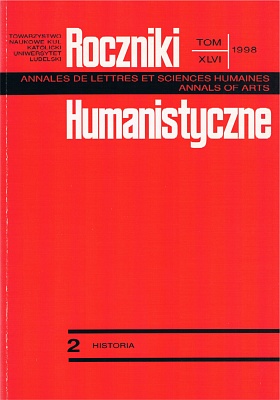Stan fizyczny i zdrowotny pensjonariuszy Szpitala Świętego Ducha w Rzymie w XVII-XVIII wieku
Abstrakt
The fate of the unwanted and abandoned children, likewise of the sick, old and poor people, has since the most ancient times been always topical. It has been a touchy social, moral and ethical problem, and difficult to be solved. The widespread phenomenon of abandoning children in Rome and its vicinity decidedly affected the decision of Pope Innocent III to found in 1198 the Holy Ghost Hospital-Poor-House in Rome, being under the jurisdiction of the order of the Holy Ghost Fathers. The principal function of this hospital, from the moment of its rise onward, was to take care about the children abandoned by their mothers or families.
It is worth noting that there was a high death rate among the children abandoned at the hospital. In the beginning of the 17th century it exceeded their total population by 30 per cent. Many children would die even before they arrived at the hospital, during secret labours deprived of any professional assistance. Then they would die during their long-awaited transport, lasting several days or several weeks, as well as during a long and exhausting journey to the poor-house. Then came a drastic selection as early as during the two-week stay in the hospital. The vast majority of the children were fed by wet nurses in appalling hygienic and sanitary conditions and very poor accommodation and they would not survive till the moment wet nurses appeared, ready to take up further care about them in their homes.
As well as their high mortality, one of the reasons why the newly born children were abandoned were their congenital and acquired diseases and other physical handicaps. The foundlings who came to the hospital had very poor health, many defects, their bodies were covered with ulcers and wounds. They were also infected with venereal diseases. A considerable part of them were disabled children.
The hospital authorities tended to give as many foundlings as possible to the women living in Rome or other places to be fed and brought up. It should be emphasized that the children given to surrogate families were in a very bad health condition. In 1705, during the visitation to the foundlings living in places outside Rome, more than fifty of them were found to be ill with serious diseases and handicaps. The most common defects were the following: unidentified handicap (storpiati), skin diseases, mycosis, itch, dwarfism, height deficiency, and ocular diseases, including partial or complete blindness. Certainly, a considerable part of diseases and physical disabilities were congenital; most of them, however, were acquired in later age, due to unfortunate accidents, e.g. knocked out eyes. Some diseases or general malaise in the children could have been due to negligence on the part of their carers. Therefore it goes without saying that various diseases present in the children entrusted to the surrogate families caused their high mortality.
After a temporary, eleven- (girls) or twelve-year (boys) long stay in the homes of their wet nurses the abandoned children had to return to the poor-house. The girls coming back from their wet nurse and thenceforth called “Zittelle,” were placed in the so-called “Conservatorio,” while the boys were put in another place, in “Scuola dei Putti.” In comparison with “Zitelle del Conservatorio,” whose number in general varied from 500 to 800, the boys educated at school (as a rule 40-50 of them) with regard to their total number in the hospital were a marginal phenomenon.
As regards the “Zitelle” living in “Conservatorio,” their health condition wes very unfavourable. A large number of handicaps and various diseases running among the “Zittelle” is confirmed by different sources of both the 17th and 18th centuries. For example, the percentage of the “Zittelle Invalide ed Informe” in relation to the total number in “Conservatorio” ranged in the last decade of the 18th century between 27 and 31%. In the beginning of the second half of that century 158 of the “Zittelle” out 940, that is 17% of the total number of inhabitants of the poor-house, suffered from various diseases, ailments and disability. It is worth noting the vast variety of handicaps and incurable diseases (“imperfezioni e mali incurabili”) from which the inhabitants of the poor-house suffered. There were as many as 96 cases of various complicated and chronic, most often permanent deformities, diseases and lesions. Most of them were congenital, rarely acquired. Among the physical defects usually there were the following: the absence of one eye, lameness, claudication, dwarfism, deficiency, hypogenesis and paresis, hump, the absence of speech, fatuity and mental debility, blindness, skin disease, immobile eye, tuberculosis, deafness, varicose veins, the absence of fingers, asthma, paralysis, epilepsy, communicable disease (imprecise), stammer, oedema and the like. Some women had simultaneously several complicated diseases and ailments, e.g. one of them did not have one eye and suffered from epilepsy, another was a paralysed asthmatic.
Copyright (c) 1998 Roczniki Humanistyczne

Utwór dostępny jest na licencji Creative Commons Uznanie autorstwa – Użycie niekomercyjne – Bez utworów zależnych 4.0 Międzynarodowe.





